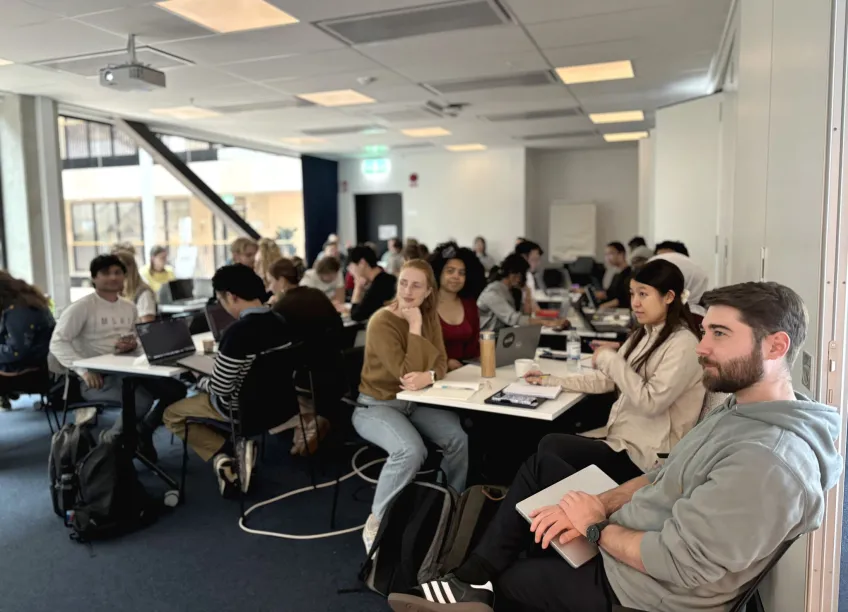When LINXS moved from its old premises at Ideon to The Loop in Science Village in March, the institute became the first research environment from Lund University to take the step to Brunnshög. Since then, activities have more than doubled, new collaborations have emerged, and the team’s mood is distinctly optimistic.
I met Anna Ntinidou, Head of Administration, Noomi Egan, Communications Officer, and Josefin Martell, Activities Coordinator, in their new office space to hear how the move has shaped their work – and what lies ahead.
From moving boxes to the first research event in ten days
The move took place on 3 March. Just ten days later, LINXS hosted its first event in the new premises at The Loop.
“We had barely finished unpacking before we filled the building with people,” laughs Anna. “For us, it was obvious from the start that LINXS should be here. The whole idea behind LINXS is about creating activities and opportunities where researchers can connect – and Science Village is exactly the right place for that.”
Since then, the pace has only increased. With rooms that can now accommodate up to 100 people – twice as many as at Ideon – LINXS has expanded its activities significantly. Two research schools have already been held in parallel, and participation from both ESS and MAX IV has grown markedly.
“You can tell that people drop by spontaneously now, which didn’t happen before,” says Josefin. “We’ve gained a whole new level of proximity to those conducting experiments at MAX IV, for example.”
Noomi agrees:
“The location makes a big difference. Being on one floor with flexible spaces means we meet each other in a much more natural way. I also think we’re quite unique within Lund University – we have a workplace where researchers from many different fields meet, both local colleagues and international scientists working with neutron and X-ray research.”
A grant that opens new possibilities
LINXS has also been strengthened by a SEK 7 million grant from the Crafoord Foundation. The funding will be used to develop the LINXS premises and equipment and develop so-called data clinics – an initiative providing researchers with support in analysing data from experiments at MAX IV, ESS, and other international neutron and X-ray facilities.
“This initiative responds to a real need,” explains Noomi. “Many researchers manage to obtain beam time but lack support for data processing. It’s a bottleneck that even the Swedish Research Council has highlighted as a major challenge. What we’ll provide is expertise, software licences, and the opportunity to work collaboratively on results.”
The first clinics are planned to open as early as 2026.
Proximity to MAX IV and ESS makes a difference
“The physical location is at least as important as the institute or network itself,” says Noomi. “The distance is much shorter now for those participating in our themes and activities – many of whom work at MAX IV and ESS. That has meant more than one might expect in scaling up our operations.”
Anna describes the move as a kind of pilot for how Lund University could establish itself in the area.
“We’re showing what it can actually mean to be here. Gaining our own experiences and insights is important for the future – both for us and for the university as a whole.”
New premises bring energy – and some challenges
When LINXS inaugurated its new space in June, the atmosphere was electric, with around 200 people attending the opening conference.
“I had just returned from parental leave and was met with a whole new energy,” says Josefin. “We’ve been able to scale up our researcher-led activities and welcome more visiting scholars. We’re also investing in our Young Researchers’ Initiative, where early-career researchers organise workshops and mini-conferences themselves.”
The team describes The Loop as a pleasant and inspiring environment, with views of both MAX IV and ESS.
“We feel incredibly good here,” says Anna. “There’s a drive and a sense of optimism in the area that’s contagious – both for us and our visitors. The support from the university and the Faculty of Science has also been crucial in making the move so successful.”
But even though most things are working well, I ask if there haven’t also been challenges along the way.
“Yes, of course!” all three say at once, laughing. “We had issues with poor mobile coverage, the AV system, and other teething problems with the building but these are being fixed along the way. The building was completed just as we moved in, so we’ve had to grow into the systems and solutions together with it,” explains Anna.
An area in motion
Now that both The Loop and Space have been completed, the area is developing rapidly. New companies are moving in, several buildings are being planned, and a vibrant start-up scene is beginning to take shape.
“There are already large life science companies here,” says Anna. “I think several research groups from the faculty and across the university could benefit from being closer once everything takes off.”
All three agree that the area will attain a major milestone once ESS opens – and they hope to see an even greater surge in activity then.
Interview by Cecilia Schubert, Communications Officer, Faculty of Science.








